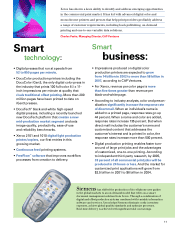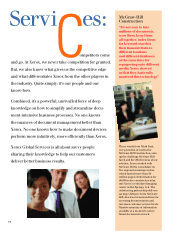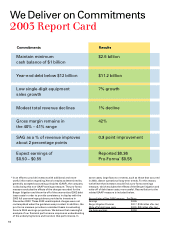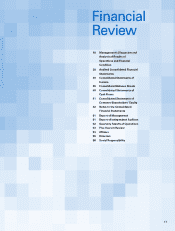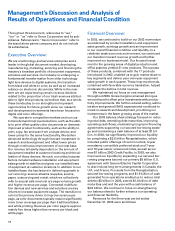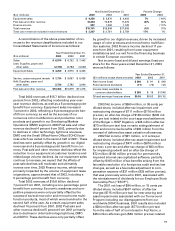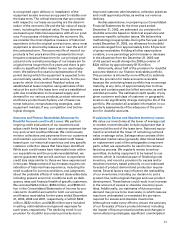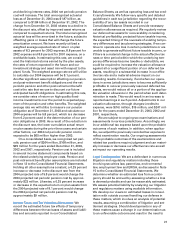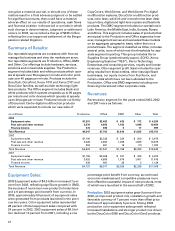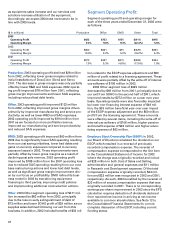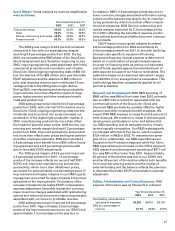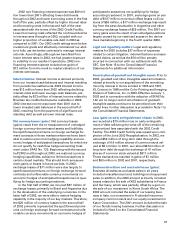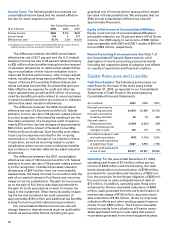Xerox 2003 Annual Report Download - page 22
Download and view the complete annual report
Please find page 22 of the 2003 Xerox annual report below. You can navigate through the pages in the report by either clicking on the pages listed below, or by using the keyword search tool below to find specific information within the annual report.
20
Revenue Recognition Under Bundled Arrangements:
As discussed more fully in Note 1 to the Consolidated
Financial Statements, we sell most of our products
and services under bundled contract arrangements,
which typically include equipment, service, supplies
and financing components for which the customer
pays a single negotiated price for all elements. These
arrangements typically also include a variable compo-
nent for page volumes in excess of contractual mini-
mums, which are often expressed in terms of price per
page, which we refer to as the “cost per copy.” In a
typical bundled arrangement, our customer is quoted
a fixed minimum monthly payment for 1) the equip-
ment, 2) the associated services and other executory
costs, 3) the financing element and 4) frequently sup-
plies. When separate prices are listed in multiple ele-
ment customer contracts, such prices may not be
representative of the fair values of those elements,
because the prices of the different components of the
arrangement may be modified through customer
negotiations, although the aggregate consideration
may remain the same. Revenues under these arrange-
ments are allocated based upon the estimated relative
fair values of each element. Our revenue allocation to
the lease deliverables begins by allocating revenues to
the maintenance and executory costs plus profit there-
on. The remaining amounts are allocated to the equip-
ment and financing elements. We perform extensive
analyses of available verifiable objective evidence of
equipment fair value based on cash selling prices dur-
ing the applicable period. The cash selling prices are
compared to the range of values included in our lease
accounting systems. The range of cash selling prices
must be reasonably consistent with the lease selling
prices, taking into account residual values that accrue
to our benefit, in order for us to determine that such
lease prices are indicative of fair value. Our pricing
interest rates, which are used in determining customer
payments, are developed based upon a variety of fac-
tors including local prevailing rates in the marketplace
and the customer’s credit history, industry and credit
class. Effective January 1, 2004, the pricing rates will
be reassessed quarterly based on changes in local pre-
vailing rates in the marketplace and will be adjusted to
the extent such rates vary by twenty-five basis points
or more, cumulatively, from the last rate in effect. The
pricing interest rates generally equal the implicit rates
within the leases, as corroborated by our comparisons
of cash to lease selling prices.
Revenue Recognition for Leases: As more fully
discussed in Note 1 to the Consolidated Financial
Statements, our accounting for leases involves specif-
ic determinations under applicable lease accounting
standards which often involve complex and prescrip-
tive provisions. These provisions affect the timing of
revenue recognition for our equipment. If the leases
qualify as sales-type capital leases, equipment revenue
to the early retirement of debt, $21 million of after-tax
gains ($29 million pre-tax) associated with unhedged
foreign currency, partially offset by $31 million
($33 million pre-tax) of increased compensation
expense associated with the suspension of dividends
for our ESOP and after-tax goodwill amortization of
$59 million ($63 million pre-tax).
Application of Critical
Accounting Policies:
In preparing our Consolidated Financial Statements
and accounting for the underlying transactions and
balances, we apply accounting policies that are
described in the Notes to the Consolidated Financial
Statements. We consider the policies discussed below
as critical to understanding our Consolidated Financial
Statements, as their application places the most signif-
icant demands on management’s judgment, since
financial reporting results rely on estimates of the
effects of matters that are inherently uncertain.
Specific risks associated with these critical accounting
policies are described in the following paragraphs.
The impacts and significant risks associated with these
policies on our business operations are discussed
throughout this MD&A where such policies affect our
reported and expected financial results. For a detailed
discussion of the application of these and other
accounting policies, see Note 1 to the Consolidated
Financial Statements.
Senior management has discussed the develop-
ment and selection of the critical accounting policies,
estimates and related disclosures, included herein,
with the Audit Committee of the Board of Directors.
Preparation of this annual report requires us to make
estimates and assumptions that affect the reported
amount of assets and liabilities, disclosure of contin-
gent assets and liabilities as of the date of our financial
statements and the reported amounts of revenue and
expenses during the reporting period. Although actual
results may differ from those estimates, we believe
the estimates are reasonable and appropriate. In
instances where different estimates could reasonably
have been used in the current period, we have dis-
closed the impact on our operations of these different
estimates. In certain instances, for instance with
respect to revenue recognition for leases, because the
accounting rules are prescriptive, it would not have
been possible to have reasonably used different esti-
mates in the current period and sensitivity information
would therefore not be appropriate. Changes in
assumptions and estimates are reflected in the period
in which they occur. The impact of such changes could
be material to our results of operations and financial
condition in any quarterly or annual period.



